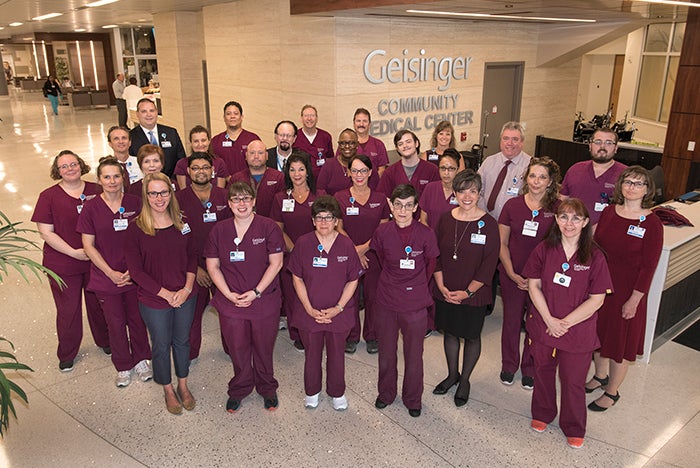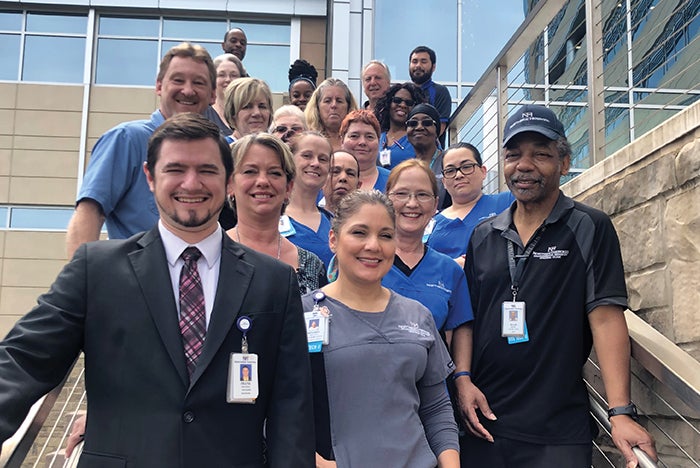Geisinger's front-line staff leans into excellence

At Geisinger Community Medical Center in Scranton, Pa., environmental services leaders are keenly aware of the critical role front-line staff play in pleasing patients at the 284-bed hospital that serves Lackawanna County and the northeastern part of Pennsylvania.
“Our front-line staff are the heartbeat of this hospital,” says David C. Leo, CHESP, director of environmental services in Geisinger’s northeast region, part of a system that serves more than 1.5 million patients in Pennsylvania and New Jersey. “Northern Pennsylvania is very blue-collar, and a lot of our staff has that background. They have a strong work ethic they pass on from one generation to another. They are passionate.”
That connection between environmental services employees and patients is demonstrated every day in the department that focuses heavily on patient-staff engagement using a variety of creative tools. For example, environmental services-themed puzzles distributed to patients not only educate patients on the role of the department but serve as a conversation starter with staff.
“Staff entering a patient’s room will ask how the person liked the puzzle,” Leo says. “Puzzles are a good way for patients to pass the time, so it’s working well.”
Such engagement ties into patient satisfaction scores, which continue to trend upward. The environmental services department’s Press Ganey courtesy scores improved from 85.8 in 2017 to 87 in 2018.
Similarly, staff engagement — bolstered by activities including action huddle boards, a Stop Light Engagement survey and quarterly CARE [Contributions, Aspirations, Results, Expectations] conversations (between the direct supervisor and a front-line employee) — increased dramatically in just one year. Engagement scores jumped from the 45th national percentile in 2017 to the 56th percentile in 2018.
“It’s extremely important to have engaged staff,” Leo says. “It drives everything we do.”
For these and numerous other accomplishments, Geisinger Community Medical Center has earned the Association for the Health Care Environment’s (AHE’s) 2019 Environmental Services Department of the Year award in the 251-500 beds category. This award recognizes outstanding performance in a number of critical categories.
A Lean methodology
The environmental services team has embraced the Lean Six Sigma (LSS) methodology that promotes multi-departmental collaboration to achieve goals, with impressive results, says Marci Butts, CHESP, director of environmental services at UC Health West Chester, Cincinnati, and a judge who scored the hospital for the AHE competition.
“The Geisinger team demonstrated significant success in many areas,” Butts says. “Through their use of Lean process improvement techniques, this department has been successful in cutting costs in waste-stream management and improving quality outcomes.”
The LSS method is key to the team’s focus on infection control and prevention. Using a black light monitoring system of high-touch points, environmental services tracks the percentage of rooms cleaned at 100%. From July 2017 to June 2018, more than 95% of rooms were cleaned at 100% compliance for cleaning all 14 high-touch points.
Lean thinking was the driver of a major 2018 initiative to comprehensively redesign the environmental services department, including reassessing daily assignments, processes and products, and enhancing patient satisfaction and employee engagement. All staff, from front-line techs to department leaders, participated in the project.
Their input was key, Leo says. “With staff feedback and task reassessment, we were able to reassign tasks and make staffing adjustments so that additional resources were allocated to patient cleaning,” he says.
One example: Environmental services technicians now clean seven fewer rooms per day (from 22 to 15), which enhances service on a number of fronts and frees staff members up to take on other duties.
The department overhaul led to other changes as well. By drilling down on data in the electronic bed management system, response times to dirty beds dropped from 47 minutes in 2017 to 35 minutes in 2018. Working with the nursing department, the environmental services staff was able to reduce noise by upgrading to quieter, more efficient carts in patient care areas, while a collaboration with infection control provided accurate data on hand hygiene.
Several product upgrades were also a step in the right direction, Butts says. Going forward, the facility will be floor-finish free, which will eliminate the need for solvent-based stripper, reducing costs.
High-tech team
Technology is critical to progress in every area, and leaders are constantly seeking upgrades. The environmental services management team relies heavily on iPads that allow staff to stay mobile and out on the floor. Pagers were phased out, and environmental services techs now carry iPhones for tasks including accepting and completing discharge cleans. Secure texting keeps information confidential and noise levels down.
“We try to keep the hardware staff carries to a minimum,” Leo says. “We’re moving more of our surveys and reports onto the iPads to keep everything in one system.”
Nurse rounding technology processes and documents patient concerns in real time while an electronic bed management system improves and tracks patient flow. Leaders look for any shortcut to save staff time. For example, physical keys for environmental services closets have been updated with keyless keypad controls.
Staff satisfaction
Because all accomplishments are tied to the front-line staff, environmental services leaders work to keep their team engaged, challenged and satisfied. Communication is vital, according to Eric Nowak, senior director of sustainability and environmental services at Geisinger.
“It’s critical that we communicate with our staff as much as they communicate with us,” Nowak says. “Having dialogue with front-line staff creates an environment where they are comfortable communicating thoughts and ideas. The key is changing the culture so that staff feel they are part of the solution along with leadership.”
The focus on staff satisfaction is paying off in critical areas. The department experienced a significant dip in staff turnover in the last year, dropping from 9.09% in 2017 to 3.28% in 2018.
“Geisinger’s decrease in turnover is seemingly a direct result of the outstanding training program and robust engagement activities,” Butts says.
Geisinger offers online academic learning sessions on infection prevention and control and ongoing Certified Health Care Environmental Services Technician (CHEST) and CHEST re-certification learning in the environmental services training center. Sign-on and retention bonuses help attract and keep talented employees.
Engagement activities like daily huddles, environmental services appreciation week and monthly staff meetings that include executive leaders are other features that keep employees satisfied, Leo says.
Having that buy-in from hospital administration is another key to success.
“It’s not just environmental services leaders communicating with the team,” Leo says. “It’s the administration as well giving their support to make sure the team has the resources they need to succeed.”



